Strategic Management Project Report: Volkswagen Company Analysis
VerifiedAdded on 2021/02/20
|16
|5208
|26
Report
AI Summary
This report provides a comprehensive strategic analysis of Volkswagen, a multinational automotive company. It begins with an introduction to strategic management and its importance in achieving organizational goals. The report then delves into an external analysis of the automotive industry and Volkswagen, utilizing the PESTEL framework to assess political, economic, social, technological, environmental, and legal factors impacting the company. Following this, an internal analysis is conducted, employing the VRIO model to evaluate Volkswagen's resources and capabilities, along with a SWOT analysis to identify strengths, weaknesses, opportunities, and threats. The report also examines Volkswagen's mission and vision statements. Finally, it proposes strategic recommendations for the company, considering the insights gained from the analyses. The report concludes by summarizing the key findings and emphasizing the significance of strategic management for Volkswagen's success in the automotive industry.
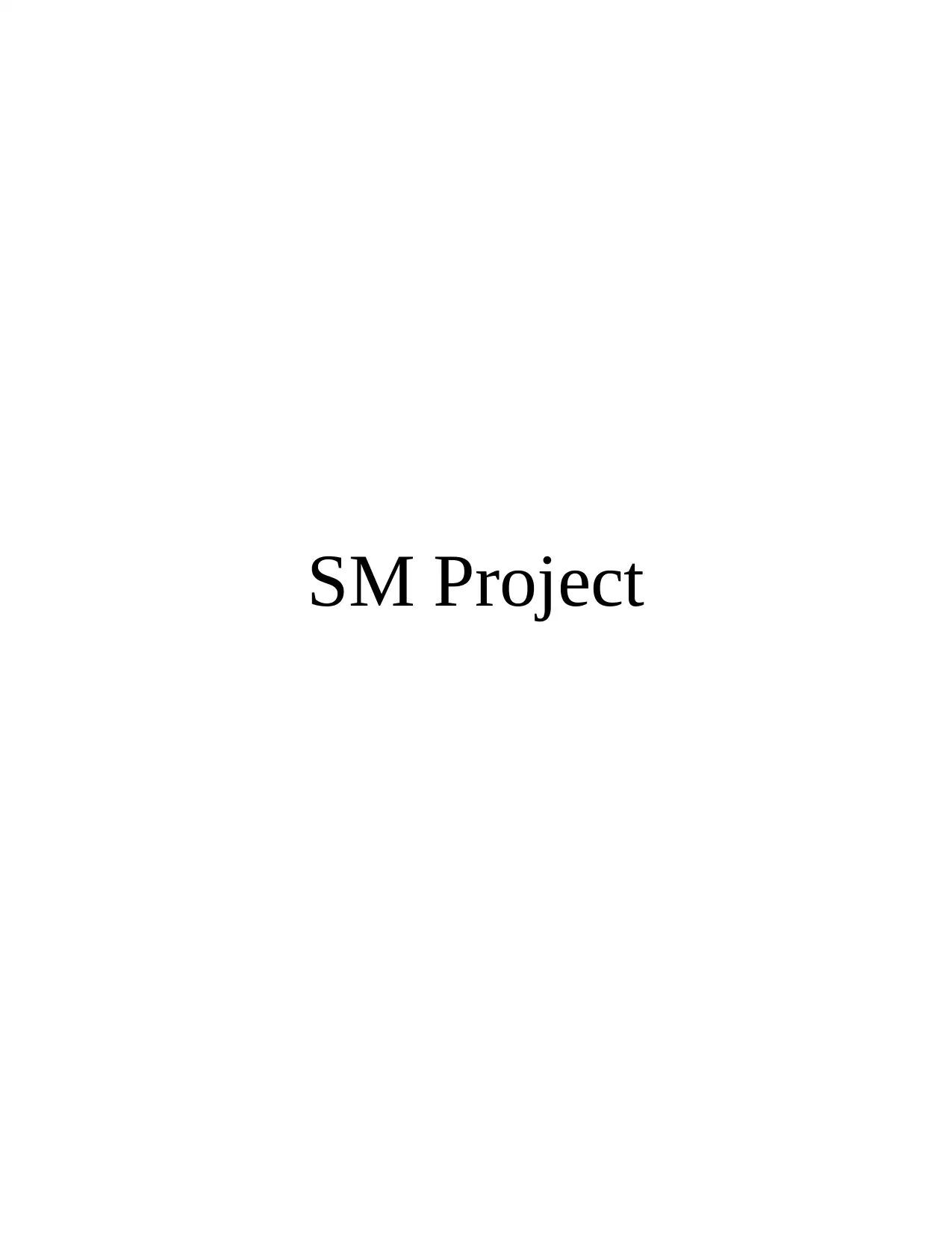
SM Project
Paraphrase This Document
Need a fresh take? Get an instant paraphrase of this document with our AI Paraphraser
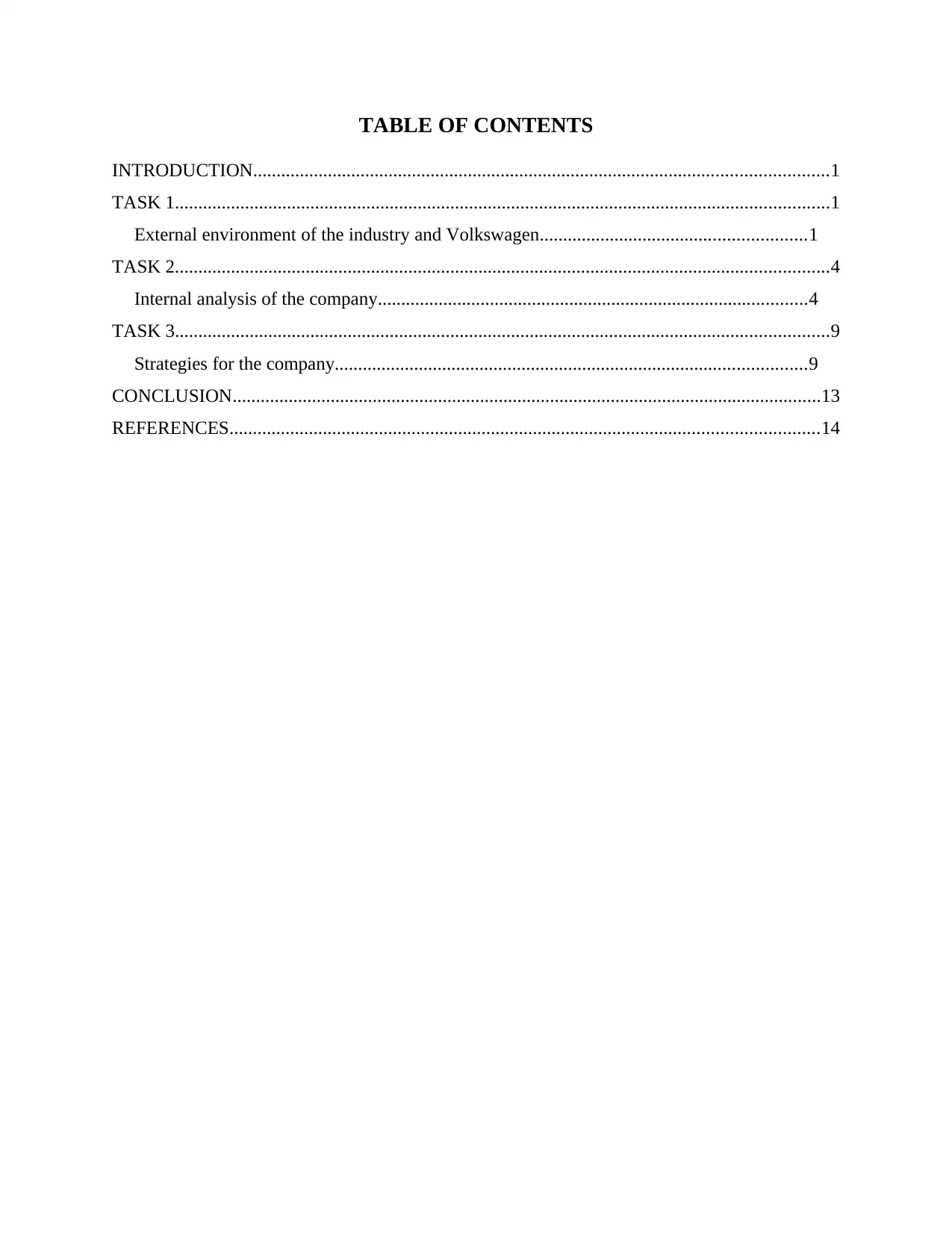
TABLE OF CONTENTS
INTRODUCTION...........................................................................................................................1
TASK 1............................................................................................................................................1
External environment of the industry and Volkswagen.........................................................1
TASK 2............................................................................................................................................4
Internal analysis of the company............................................................................................4
TASK 3............................................................................................................................................9
Strategies for the company.....................................................................................................9
CONCLUSION..............................................................................................................................13
REFERENCES..............................................................................................................................14
INTRODUCTION...........................................................................................................................1
TASK 1............................................................................................................................................1
External environment of the industry and Volkswagen.........................................................1
TASK 2............................................................................................................................................4
Internal analysis of the company............................................................................................4
TASK 3............................................................................................................................................9
Strategies for the company.....................................................................................................9
CONCLUSION..............................................................................................................................13
REFERENCES..............................................................................................................................14
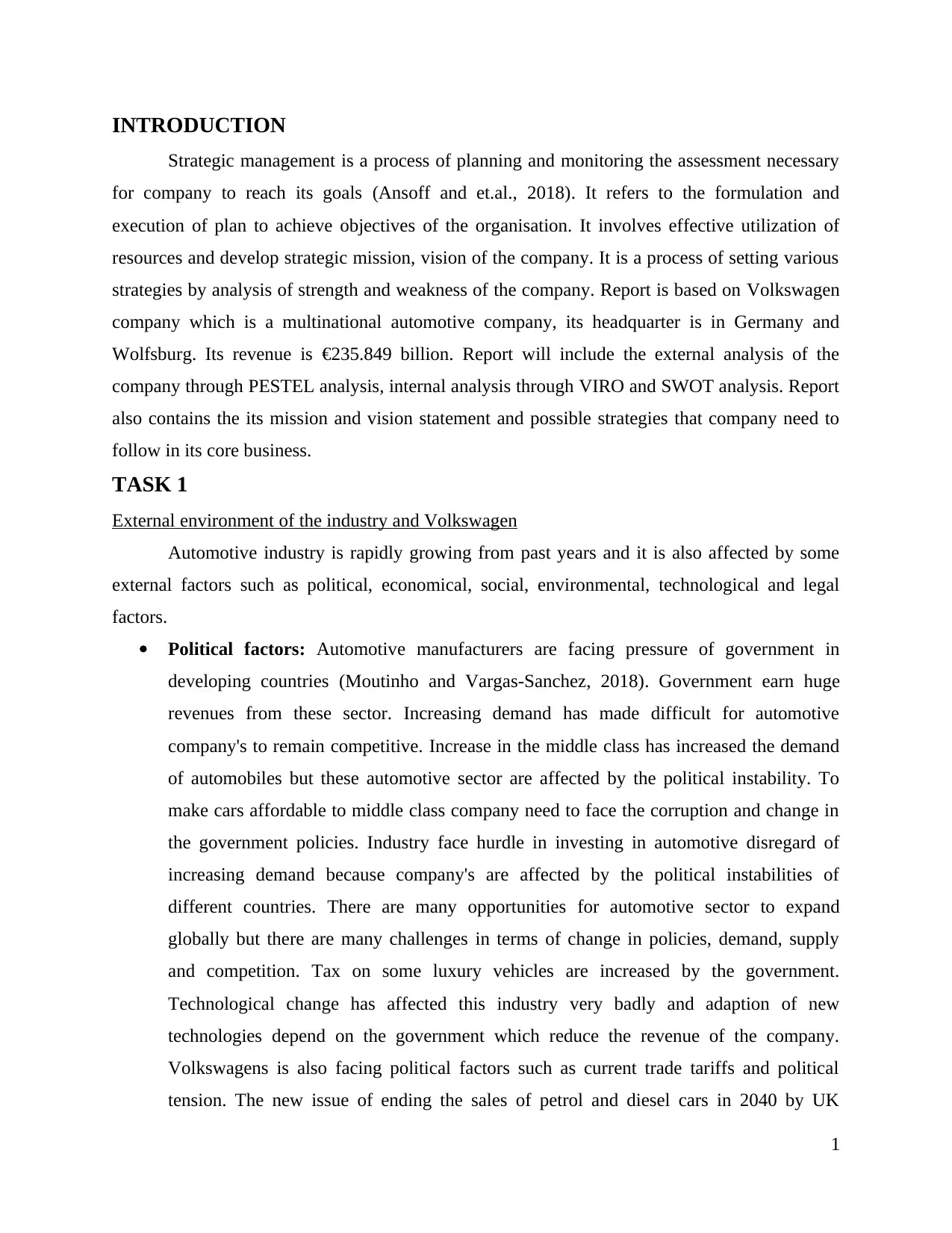
INTRODUCTION
Strategic management is a process of planning and monitoring the assessment necessary
for company to reach its goals (Ansoff and et.al., 2018). It refers to the formulation and
execution of plan to achieve objectives of the organisation. It involves effective utilization of
resources and develop strategic mission, vision of the company. It is a process of setting various
strategies by analysis of strength and weakness of the company. Report is based on Volkswagen
company which is a multinational automotive company, its headquarter is in Germany and
Wolfsburg. Its revenue is €235.849 billion. Report will include the external analysis of the
company through PESTEL analysis, internal analysis through VIRO and SWOT analysis. Report
also contains the its mission and vision statement and possible strategies that company need to
follow in its core business.
TASK 1
External environment of the industry and Volkswagen
Automotive industry is rapidly growing from past years and it is also affected by some
external factors such as political, economical, social, environmental, technological and legal
factors.
Political factors: Automotive manufacturers are facing pressure of government in
developing countries (Moutinho and Vargas-Sanchez, 2018). Government earn huge
revenues from these sector. Increasing demand has made difficult for automotive
company's to remain competitive. Increase in the middle class has increased the demand
of automobiles but these automotive sector are affected by the political instability. To
make cars affordable to middle class company need to face the corruption and change in
the government policies. Industry face hurdle in investing in automotive disregard of
increasing demand because company's are affected by the political instabilities of
different countries. There are many opportunities for automotive sector to expand
globally but there are many challenges in terms of change in policies, demand, supply
and competition. Tax on some luxury vehicles are increased by the government.
Technological change has affected this industry very badly and adaption of new
technologies depend on the government which reduce the revenue of the company.
Volkswagens is also facing political factors such as current trade tariffs and political
tension. The new issue of ending the sales of petrol and diesel cars in 2040 by UK
1
Strategic management is a process of planning and monitoring the assessment necessary
for company to reach its goals (Ansoff and et.al., 2018). It refers to the formulation and
execution of plan to achieve objectives of the organisation. It involves effective utilization of
resources and develop strategic mission, vision of the company. It is a process of setting various
strategies by analysis of strength and weakness of the company. Report is based on Volkswagen
company which is a multinational automotive company, its headquarter is in Germany and
Wolfsburg. Its revenue is €235.849 billion. Report will include the external analysis of the
company through PESTEL analysis, internal analysis through VIRO and SWOT analysis. Report
also contains the its mission and vision statement and possible strategies that company need to
follow in its core business.
TASK 1
External environment of the industry and Volkswagen
Automotive industry is rapidly growing from past years and it is also affected by some
external factors such as political, economical, social, environmental, technological and legal
factors.
Political factors: Automotive manufacturers are facing pressure of government in
developing countries (Moutinho and Vargas-Sanchez, 2018). Government earn huge
revenues from these sector. Increasing demand has made difficult for automotive
company's to remain competitive. Increase in the middle class has increased the demand
of automobiles but these automotive sector are affected by the political instability. To
make cars affordable to middle class company need to face the corruption and change in
the government policies. Industry face hurdle in investing in automotive disregard of
increasing demand because company's are affected by the political instabilities of
different countries. There are many opportunities for automotive sector to expand
globally but there are many challenges in terms of change in policies, demand, supply
and competition. Tax on some luxury vehicles are increased by the government.
Technological change has affected this industry very badly and adaption of new
technologies depend on the government which reduce the revenue of the company.
Volkswagens is also facing political factors such as current trade tariffs and political
tension. The new issue of ending the sales of petrol and diesel cars in 2040 by UK
1
⊘ This is a preview!⊘
Do you want full access?
Subscribe today to unlock all pages.

Trusted by 1+ million students worldwide
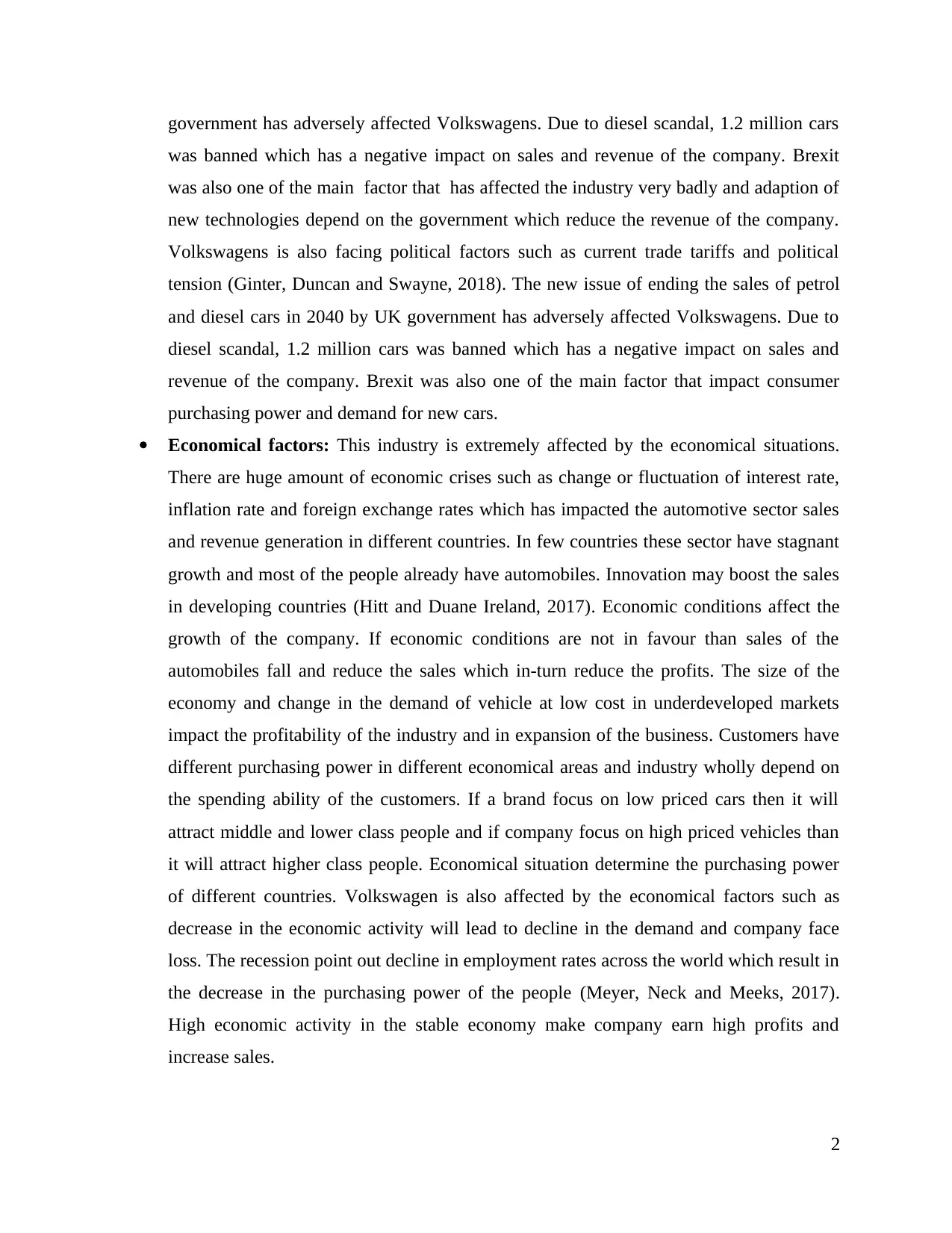
government has adversely affected Volkswagens. Due to diesel scandal, 1.2 million cars
was banned which has a negative impact on sales and revenue of the company. Brexit
was also one of the main factor that has affected the industry very badly and adaption of
new technologies depend on the government which reduce the revenue of the company.
Volkswagens is also facing political factors such as current trade tariffs and political
tension (Ginter, Duncan and Swayne, 2018). The new issue of ending the sales of petrol
and diesel cars in 2040 by UK government has adversely affected Volkswagens. Due to
diesel scandal, 1.2 million cars was banned which has a negative impact on sales and
revenue of the company. Brexit was also one of the main factor that impact consumer
purchasing power and demand for new cars.
Economical factors: This industry is extremely affected by the economical situations.
There are huge amount of economic crises such as change or fluctuation of interest rate,
inflation rate and foreign exchange rates which has impacted the automotive sector sales
and revenue generation in different countries. In few countries these sector have stagnant
growth and most of the people already have automobiles. Innovation may boost the sales
in developing countries (Hitt and Duane Ireland, 2017). Economic conditions affect the
growth of the company. If economic conditions are not in favour than sales of the
automobiles fall and reduce the sales which in-turn reduce the profits. The size of the
economy and change in the demand of vehicle at low cost in underdeveloped markets
impact the profitability of the industry and in expansion of the business. Customers have
different purchasing power in different economical areas and industry wholly depend on
the spending ability of the customers. If a brand focus on low priced cars then it will
attract middle and lower class people and if company focus on high priced vehicles than
it will attract higher class people. Economical situation determine the purchasing power
of different countries. Volkswagen is also affected by the economical factors such as
decrease in the economic activity will lead to decline in the demand and company face
loss. The recession point out decline in employment rates across the world which result in
the decrease in the purchasing power of the people (Meyer, Neck and Meeks, 2017).
High economic activity in the stable economy make company earn high profits and
increase sales.
2
was banned which has a negative impact on sales and revenue of the company. Brexit
was also one of the main factor that has affected the industry very badly and adaption of
new technologies depend on the government which reduce the revenue of the company.
Volkswagens is also facing political factors such as current trade tariffs and political
tension (Ginter, Duncan and Swayne, 2018). The new issue of ending the sales of petrol
and diesel cars in 2040 by UK government has adversely affected Volkswagens. Due to
diesel scandal, 1.2 million cars was banned which has a negative impact on sales and
revenue of the company. Brexit was also one of the main factor that impact consumer
purchasing power and demand for new cars.
Economical factors: This industry is extremely affected by the economical situations.
There are huge amount of economic crises such as change or fluctuation of interest rate,
inflation rate and foreign exchange rates which has impacted the automotive sector sales
and revenue generation in different countries. In few countries these sector have stagnant
growth and most of the people already have automobiles. Innovation may boost the sales
in developing countries (Hitt and Duane Ireland, 2017). Economic conditions affect the
growth of the company. If economic conditions are not in favour than sales of the
automobiles fall and reduce the sales which in-turn reduce the profits. The size of the
economy and change in the demand of vehicle at low cost in underdeveloped markets
impact the profitability of the industry and in expansion of the business. Customers have
different purchasing power in different economical areas and industry wholly depend on
the spending ability of the customers. If a brand focus on low priced cars then it will
attract middle and lower class people and if company focus on high priced vehicles than
it will attract higher class people. Economical situation determine the purchasing power
of different countries. Volkswagen is also affected by the economical factors such as
decrease in the economic activity will lead to decline in the demand and company face
loss. The recession point out decline in employment rates across the world which result in
the decrease in the purchasing power of the people (Meyer, Neck and Meeks, 2017).
High economic activity in the stable economy make company earn high profits and
increase sales.
2
Paraphrase This Document
Need a fresh take? Get an instant paraphrase of this document with our AI Paraphraser
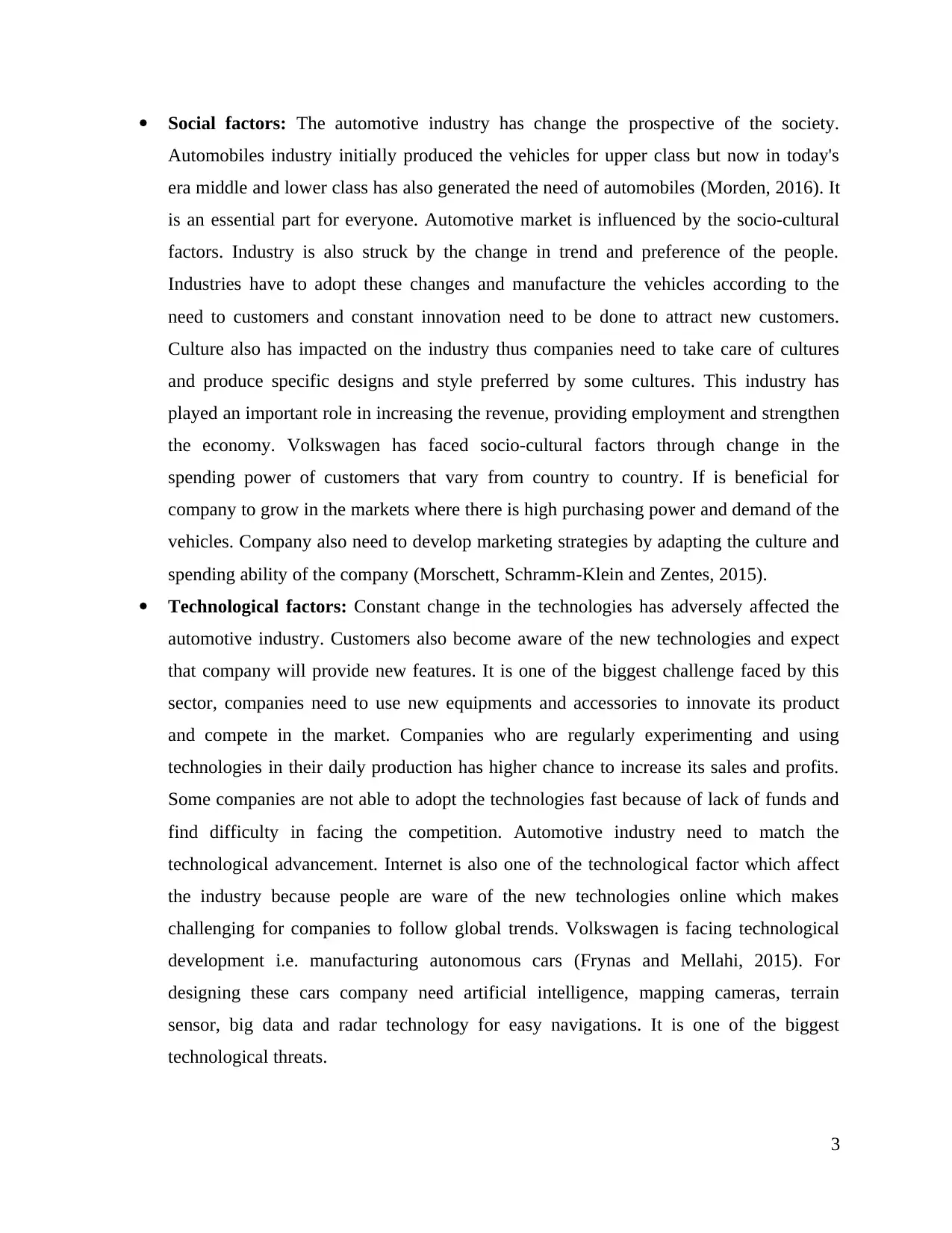
Social factors: The automotive industry has change the prospective of the society.
Automobiles industry initially produced the vehicles for upper class but now in today's
era middle and lower class has also generated the need of automobiles (Morden, 2016). It
is an essential part for everyone. Automotive market is influenced by the socio-cultural
factors. Industry is also struck by the change in trend and preference of the people.
Industries have to adopt these changes and manufacture the vehicles according to the
need to customers and constant innovation need to be done to attract new customers.
Culture also has impacted on the industry thus companies need to take care of cultures
and produce specific designs and style preferred by some cultures. This industry has
played an important role in increasing the revenue, providing employment and strengthen
the economy. Volkswagen has faced socio-cultural factors through change in the
spending power of customers that vary from country to country. If is beneficial for
company to grow in the markets where there is high purchasing power and demand of the
vehicles. Company also need to develop marketing strategies by adapting the culture and
spending ability of the company (Morschett, Schramm-Klein and Zentes, 2015).
Technological factors: Constant change in the technologies has adversely affected the
automotive industry. Customers also become aware of the new technologies and expect
that company will provide new features. It is one of the biggest challenge faced by this
sector, companies need to use new equipments and accessories to innovate its product
and compete in the market. Companies who are regularly experimenting and using
technologies in their daily production has higher chance to increase its sales and profits.
Some companies are not able to adopt the technologies fast because of lack of funds and
find difficulty in facing the competition. Automotive industry need to match the
technological advancement. Internet is also one of the technological factor which affect
the industry because people are ware of the new technologies online which makes
challenging for companies to follow global trends. Volkswagen is facing technological
development i.e. manufacturing autonomous cars (Frynas and Mellahi, 2015). For
designing these cars company need artificial intelligence, mapping cameras, terrain
sensor, big data and radar technology for easy navigations. It is one of the biggest
technological threats.
3
Automobiles industry initially produced the vehicles for upper class but now in today's
era middle and lower class has also generated the need of automobiles (Morden, 2016). It
is an essential part for everyone. Automotive market is influenced by the socio-cultural
factors. Industry is also struck by the change in trend and preference of the people.
Industries have to adopt these changes and manufacture the vehicles according to the
need to customers and constant innovation need to be done to attract new customers.
Culture also has impacted on the industry thus companies need to take care of cultures
and produce specific designs and style preferred by some cultures. This industry has
played an important role in increasing the revenue, providing employment and strengthen
the economy. Volkswagen has faced socio-cultural factors through change in the
spending power of customers that vary from country to country. If is beneficial for
company to grow in the markets where there is high purchasing power and demand of the
vehicles. Company also need to develop marketing strategies by adapting the culture and
spending ability of the company (Morschett, Schramm-Klein and Zentes, 2015).
Technological factors: Constant change in the technologies has adversely affected the
automotive industry. Customers also become aware of the new technologies and expect
that company will provide new features. It is one of the biggest challenge faced by this
sector, companies need to use new equipments and accessories to innovate its product
and compete in the market. Companies who are regularly experimenting and using
technologies in their daily production has higher chance to increase its sales and profits.
Some companies are not able to adopt the technologies fast because of lack of funds and
find difficulty in facing the competition. Automotive industry need to match the
technological advancement. Internet is also one of the technological factor which affect
the industry because people are ware of the new technologies online which makes
challenging for companies to follow global trends. Volkswagen is facing technological
development i.e. manufacturing autonomous cars (Frynas and Mellahi, 2015). For
designing these cars company need artificial intelligence, mapping cameras, terrain
sensor, big data and radar technology for easy navigations. It is one of the biggest
technological threats.
3
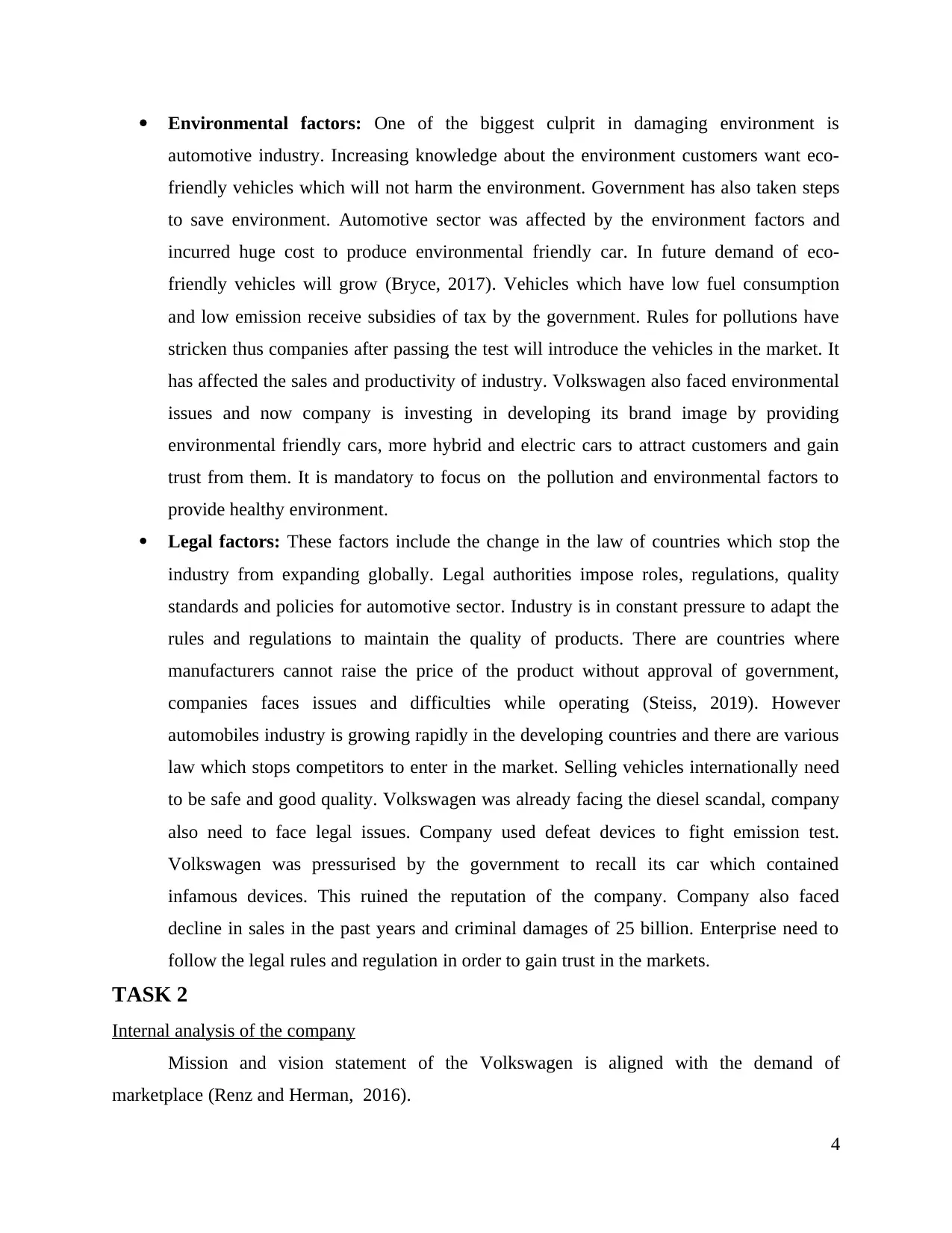
Environmental factors: One of the biggest culprit in damaging environment is
automotive industry. Increasing knowledge about the environment customers want eco-
friendly vehicles which will not harm the environment. Government has also taken steps
to save environment. Automotive sector was affected by the environment factors and
incurred huge cost to produce environmental friendly car. In future demand of eco-
friendly vehicles will grow (Bryce, 2017). Vehicles which have low fuel consumption
and low emission receive subsidies of tax by the government. Rules for pollutions have
stricken thus companies after passing the test will introduce the vehicles in the market. It
has affected the sales and productivity of industry. Volkswagen also faced environmental
issues and now company is investing in developing its brand image by providing
environmental friendly cars, more hybrid and electric cars to attract customers and gain
trust from them. It is mandatory to focus on the pollution and environmental factors to
provide healthy environment.
Legal factors: These factors include the change in the law of countries which stop the
industry from expanding globally. Legal authorities impose roles, regulations, quality
standards and policies for automotive sector. Industry is in constant pressure to adapt the
rules and regulations to maintain the quality of products. There are countries where
manufacturers cannot raise the price of the product without approval of government,
companies faces issues and difficulties while operating (Steiss, 2019). However
automobiles industry is growing rapidly in the developing countries and there are various
law which stops competitors to enter in the market. Selling vehicles internationally need
to be safe and good quality. Volkswagen was already facing the diesel scandal, company
also need to face legal issues. Company used defeat devices to fight emission test.
Volkswagen was pressurised by the government to recall its car which contained
infamous devices. This ruined the reputation of the company. Company also faced
decline in sales in the past years and criminal damages of 25 billion. Enterprise need to
follow the legal rules and regulation in order to gain trust in the markets.
TASK 2
Internal analysis of the company
Mission and vision statement of the Volkswagen is aligned with the demand of
marketplace (Renz and Herman, 2016).
4
automotive industry. Increasing knowledge about the environment customers want eco-
friendly vehicles which will not harm the environment. Government has also taken steps
to save environment. Automotive sector was affected by the environment factors and
incurred huge cost to produce environmental friendly car. In future demand of eco-
friendly vehicles will grow (Bryce, 2017). Vehicles which have low fuel consumption
and low emission receive subsidies of tax by the government. Rules for pollutions have
stricken thus companies after passing the test will introduce the vehicles in the market. It
has affected the sales and productivity of industry. Volkswagen also faced environmental
issues and now company is investing in developing its brand image by providing
environmental friendly cars, more hybrid and electric cars to attract customers and gain
trust from them. It is mandatory to focus on the pollution and environmental factors to
provide healthy environment.
Legal factors: These factors include the change in the law of countries which stop the
industry from expanding globally. Legal authorities impose roles, regulations, quality
standards and policies for automotive sector. Industry is in constant pressure to adapt the
rules and regulations to maintain the quality of products. There are countries where
manufacturers cannot raise the price of the product without approval of government,
companies faces issues and difficulties while operating (Steiss, 2019). However
automobiles industry is growing rapidly in the developing countries and there are various
law which stops competitors to enter in the market. Selling vehicles internationally need
to be safe and good quality. Volkswagen was already facing the diesel scandal, company
also need to face legal issues. Company used defeat devices to fight emission test.
Volkswagen was pressurised by the government to recall its car which contained
infamous devices. This ruined the reputation of the company. Company also faced
decline in sales in the past years and criminal damages of 25 billion. Enterprise need to
follow the legal rules and regulation in order to gain trust in the markets.
TASK 2
Internal analysis of the company
Mission and vision statement of the Volkswagen is aligned with the demand of
marketplace (Renz and Herman, 2016).
4
⊘ This is a preview!⊘
Do you want full access?
Subscribe today to unlock all pages.

Trusted by 1+ million students worldwide
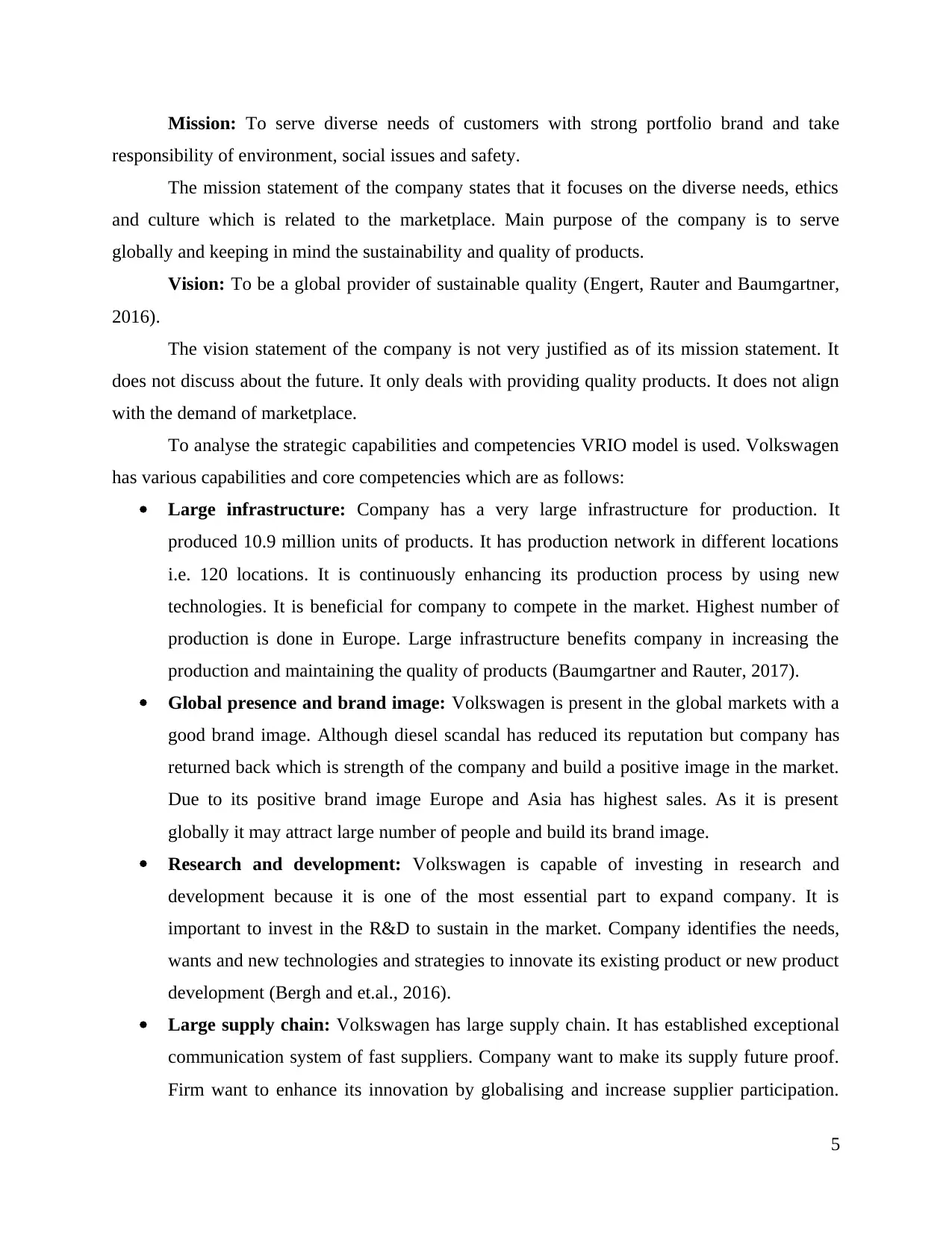
Mission: To serve diverse needs of customers with strong portfolio brand and take
responsibility of environment, social issues and safety.
The mission statement of the company states that it focuses on the diverse needs, ethics
and culture which is related to the marketplace. Main purpose of the company is to serve
globally and keeping in mind the sustainability and quality of products.
Vision: To be a global provider of sustainable quality (Engert, Rauter and Baumgartner,
2016).
The vision statement of the company is not very justified as of its mission statement. It
does not discuss about the future. It only deals with providing quality products. It does not align
with the demand of marketplace.
To analyse the strategic capabilities and competencies VRIO model is used. Volkswagen
has various capabilities and core competencies which are as follows:
Large infrastructure: Company has a very large infrastructure for production. It
produced 10.9 million units of products. It has production network in different locations
i.e. 120 locations. It is continuously enhancing its production process by using new
technologies. It is beneficial for company to compete in the market. Highest number of
production is done in Europe. Large infrastructure benefits company in increasing the
production and maintaining the quality of products (Baumgartner and Rauter, 2017).
Global presence and brand image: Volkswagen is present in the global markets with a
good brand image. Although diesel scandal has reduced its reputation but company has
returned back which is strength of the company and build a positive image in the market.
Due to its positive brand image Europe and Asia has highest sales. As it is present
globally it may attract large number of people and build its brand image.
Research and development: Volkswagen is capable of investing in research and
development because it is one of the most essential part to expand company. It is
important to invest in the R&D to sustain in the market. Company identifies the needs,
wants and new technologies and strategies to innovate its existing product or new product
development (Bergh and et.al., 2016).
Large supply chain: Volkswagen has large supply chain. It has established exceptional
communication system of fast suppliers. Company want to make its supply future proof.
Firm want to enhance its innovation by globalising and increase supplier participation.
5
responsibility of environment, social issues and safety.
The mission statement of the company states that it focuses on the diverse needs, ethics
and culture which is related to the marketplace. Main purpose of the company is to serve
globally and keeping in mind the sustainability and quality of products.
Vision: To be a global provider of sustainable quality (Engert, Rauter and Baumgartner,
2016).
The vision statement of the company is not very justified as of its mission statement. It
does not discuss about the future. It only deals with providing quality products. It does not align
with the demand of marketplace.
To analyse the strategic capabilities and competencies VRIO model is used. Volkswagen
has various capabilities and core competencies which are as follows:
Large infrastructure: Company has a very large infrastructure for production. It
produced 10.9 million units of products. It has production network in different locations
i.e. 120 locations. It is continuously enhancing its production process by using new
technologies. It is beneficial for company to compete in the market. Highest number of
production is done in Europe. Large infrastructure benefits company in increasing the
production and maintaining the quality of products (Baumgartner and Rauter, 2017).
Global presence and brand image: Volkswagen is present in the global markets with a
good brand image. Although diesel scandal has reduced its reputation but company has
returned back which is strength of the company and build a positive image in the market.
Due to its positive brand image Europe and Asia has highest sales. As it is present
globally it may attract large number of people and build its brand image.
Research and development: Volkswagen is capable of investing in research and
development because it is one of the most essential part to expand company. It is
important to invest in the R&D to sustain in the market. Company identifies the needs,
wants and new technologies and strategies to innovate its existing product or new product
development (Bergh and et.al., 2016).
Large supply chain: Volkswagen has large supply chain. It has established exceptional
communication system of fast suppliers. Company want to make its supply future proof.
Firm want to enhance its innovation by globalising and increase supplier participation.
5
Paraphrase This Document
Need a fresh take? Get an instant paraphrase of this document with our AI Paraphraser
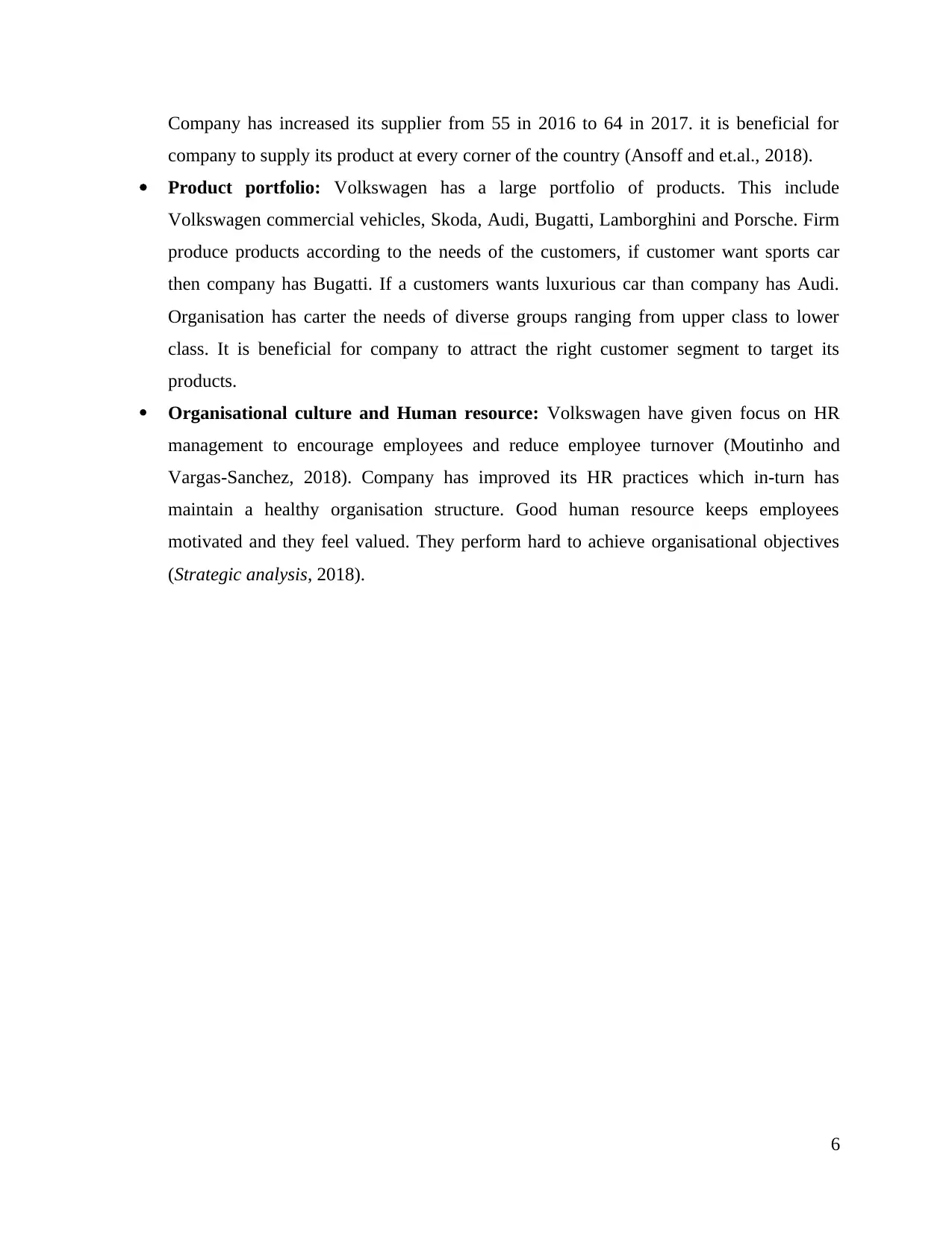
Company has increased its supplier from 55 in 2016 to 64 in 2017. it is beneficial for
company to supply its product at every corner of the country (Ansoff and et.al., 2018).
Product portfolio: Volkswagen has a large portfolio of products. This include
Volkswagen commercial vehicles, Skoda, Audi, Bugatti, Lamborghini and Porsche. Firm
produce products according to the needs of the customers, if customer want sports car
then company has Bugatti. If a customers wants luxurious car than company has Audi.
Organisation has carter the needs of diverse groups ranging from upper class to lower
class. It is beneficial for company to attract the right customer segment to target its
products.
Organisational culture and Human resource: Volkswagen have given focus on HR
management to encourage employees and reduce employee turnover (Moutinho and
Vargas-Sanchez, 2018). Company has improved its HR practices which in-turn has
maintain a healthy organisation structure. Good human resource keeps employees
motivated and they feel valued. They perform hard to achieve organisational objectives
(Strategic analysis, 2018).
6
company to supply its product at every corner of the country (Ansoff and et.al., 2018).
Product portfolio: Volkswagen has a large portfolio of products. This include
Volkswagen commercial vehicles, Skoda, Audi, Bugatti, Lamborghini and Porsche. Firm
produce products according to the needs of the customers, if customer want sports car
then company has Bugatti. If a customers wants luxurious car than company has Audi.
Organisation has carter the needs of diverse groups ranging from upper class to lower
class. It is beneficial for company to attract the right customer segment to target its
products.
Organisational culture and Human resource: Volkswagen have given focus on HR
management to encourage employees and reduce employee turnover (Moutinho and
Vargas-Sanchez, 2018). Company has improved its HR practices which in-turn has
maintain a healthy organisation structure. Good human resource keeps employees
motivated and they feel valued. They perform hard to achieve organisational objectives
(Strategic analysis, 2018).
6
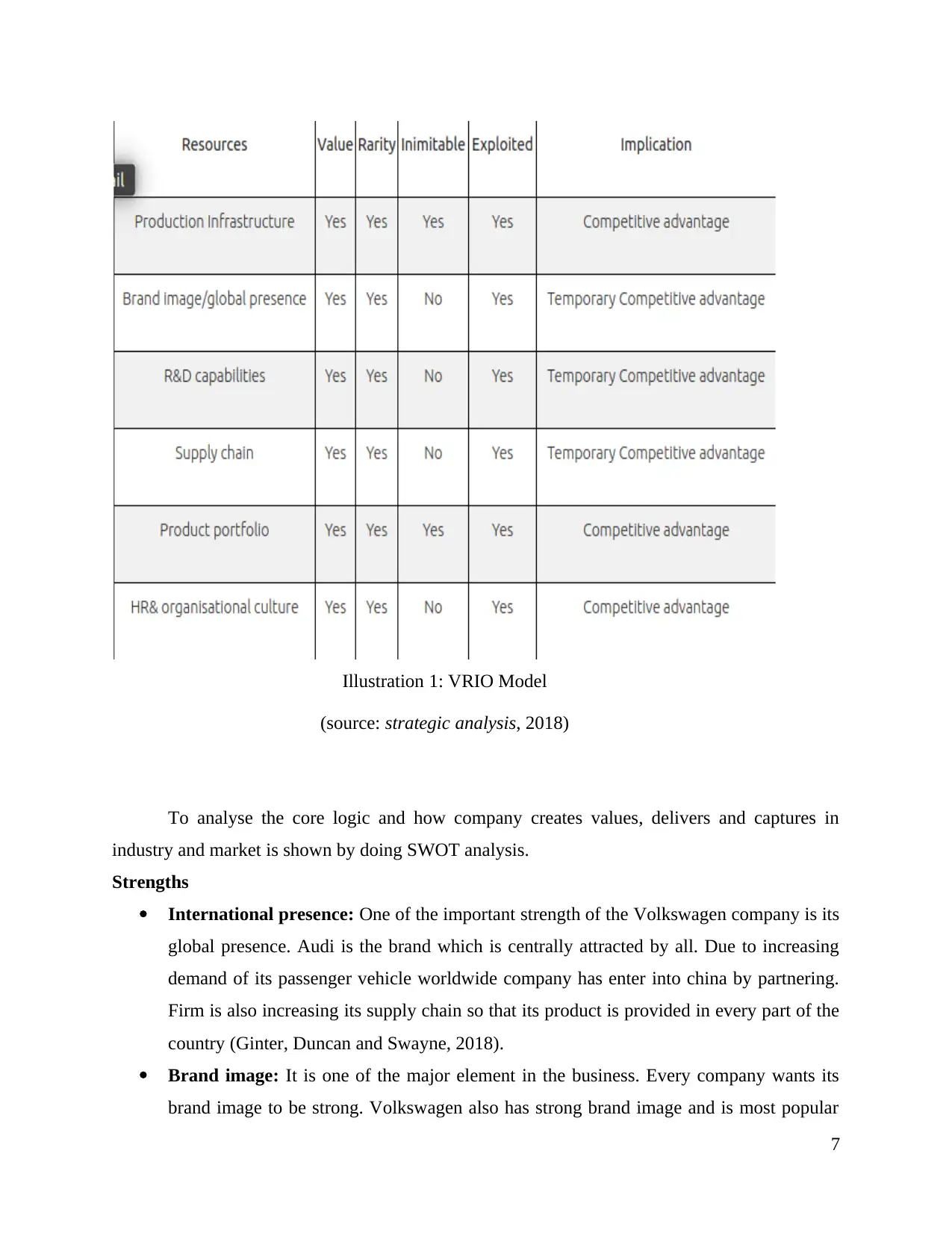
Illustration 1: VRIO Model
(source: strategic analysis, 2018)
To analyse the core logic and how company creates values, delivers and captures in
industry and market is shown by doing SWOT analysis.
Strengths
International presence: One of the important strength of the Volkswagen company is its
global presence. Audi is the brand which is centrally attracted by all. Due to increasing
demand of its passenger vehicle worldwide company has enter into china by partnering.
Firm is also increasing its supply chain so that its product is provided in every part of the
country (Ginter, Duncan and Swayne, 2018).
Brand image: It is one of the major element in the business. Every company wants its
brand image to be strong. Volkswagen also has strong brand image and is most popular
7
(source: strategic analysis, 2018)
To analyse the core logic and how company creates values, delivers and captures in
industry and market is shown by doing SWOT analysis.
Strengths
International presence: One of the important strength of the Volkswagen company is its
global presence. Audi is the brand which is centrally attracted by all. Due to increasing
demand of its passenger vehicle worldwide company has enter into china by partnering.
Firm is also increasing its supply chain so that its product is provided in every part of the
country (Ginter, Duncan and Swayne, 2018).
Brand image: It is one of the major element in the business. Every company wants its
brand image to be strong. Volkswagen also has strong brand image and is most popular
7
⊘ This is a preview!⊘
Do you want full access?
Subscribe today to unlock all pages.

Trusted by 1+ million students worldwide
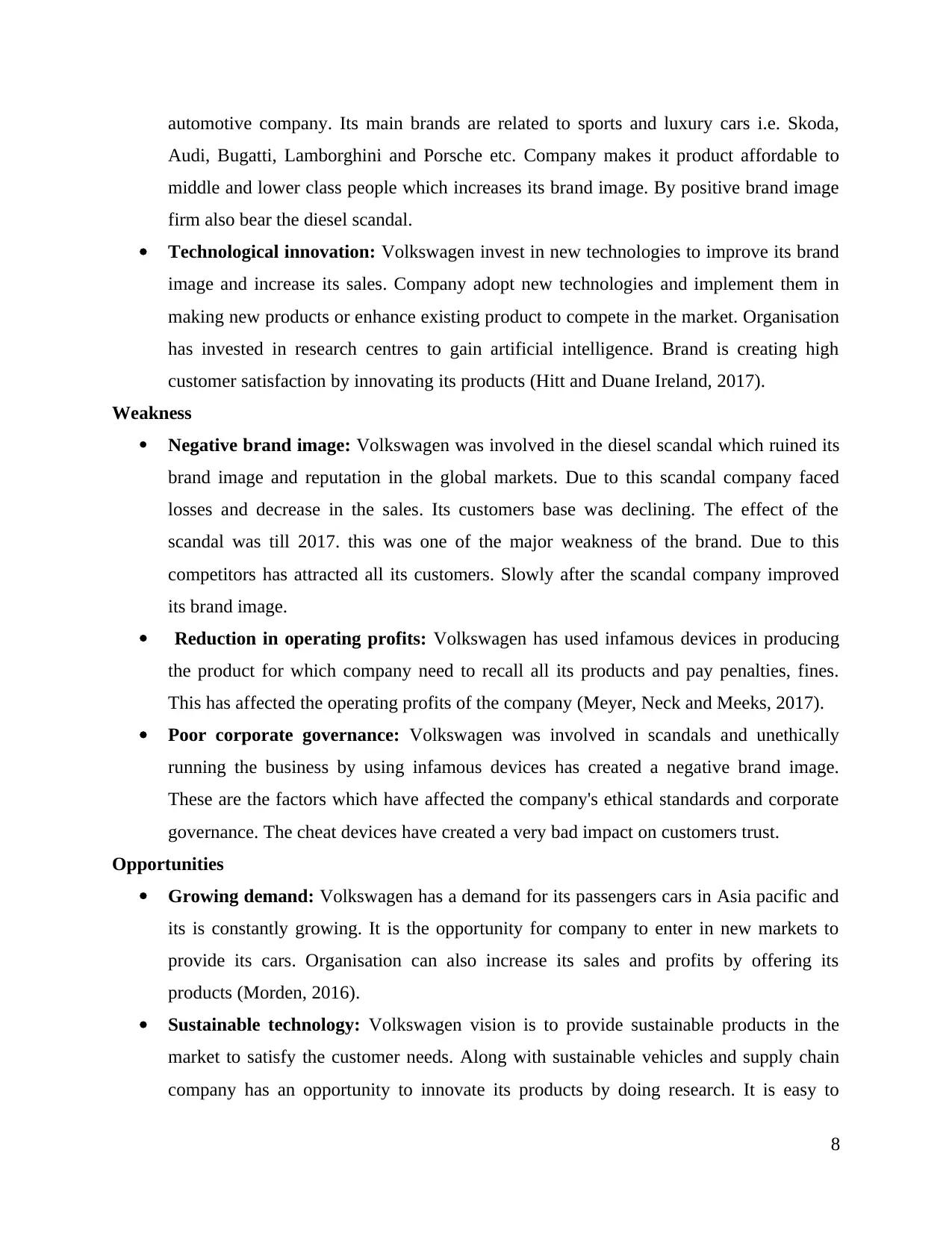
automotive company. Its main brands are related to sports and luxury cars i.e. Skoda,
Audi, Bugatti, Lamborghini and Porsche etc. Company makes it product affordable to
middle and lower class people which increases its brand image. By positive brand image
firm also bear the diesel scandal.
Technological innovation: Volkswagen invest in new technologies to improve its brand
image and increase its sales. Company adopt new technologies and implement them in
making new products or enhance existing product to compete in the market. Organisation
has invested in research centres to gain artificial intelligence. Brand is creating high
customer satisfaction by innovating its products (Hitt and Duane Ireland, 2017).
Weakness
Negative brand image: Volkswagen was involved in the diesel scandal which ruined its
brand image and reputation in the global markets. Due to this scandal company faced
losses and decrease in the sales. Its customers base was declining. The effect of the
scandal was till 2017. this was one of the major weakness of the brand. Due to this
competitors has attracted all its customers. Slowly after the scandal company improved
its brand image.
Reduction in operating profits: Volkswagen has used infamous devices in producing
the product for which company need to recall all its products and pay penalties, fines.
This has affected the operating profits of the company (Meyer, Neck and Meeks, 2017).
Poor corporate governance: Volkswagen was involved in scandals and unethically
running the business by using infamous devices has created a negative brand image.
These are the factors which have affected the company's ethical standards and corporate
governance. The cheat devices have created a very bad impact on customers trust.
Opportunities
Growing demand: Volkswagen has a demand for its passengers cars in Asia pacific and
its is constantly growing. It is the opportunity for company to enter in new markets to
provide its cars. Organisation can also increase its sales and profits by offering its
products (Morden, 2016).
Sustainable technology: Volkswagen vision is to provide sustainable products in the
market to satisfy the customer needs. Along with sustainable vehicles and supply chain
company has an opportunity to innovate its products by doing research. It is easy to
8
Audi, Bugatti, Lamborghini and Porsche etc. Company makes it product affordable to
middle and lower class people which increases its brand image. By positive brand image
firm also bear the diesel scandal.
Technological innovation: Volkswagen invest in new technologies to improve its brand
image and increase its sales. Company adopt new technologies and implement them in
making new products or enhance existing product to compete in the market. Organisation
has invested in research centres to gain artificial intelligence. Brand is creating high
customer satisfaction by innovating its products (Hitt and Duane Ireland, 2017).
Weakness
Negative brand image: Volkswagen was involved in the diesel scandal which ruined its
brand image and reputation in the global markets. Due to this scandal company faced
losses and decrease in the sales. Its customers base was declining. The effect of the
scandal was till 2017. this was one of the major weakness of the brand. Due to this
competitors has attracted all its customers. Slowly after the scandal company improved
its brand image.
Reduction in operating profits: Volkswagen has used infamous devices in producing
the product for which company need to recall all its products and pay penalties, fines.
This has affected the operating profits of the company (Meyer, Neck and Meeks, 2017).
Poor corporate governance: Volkswagen was involved in scandals and unethically
running the business by using infamous devices has created a negative brand image.
These are the factors which have affected the company's ethical standards and corporate
governance. The cheat devices have created a very bad impact on customers trust.
Opportunities
Growing demand: Volkswagen has a demand for its passengers cars in Asia pacific and
its is constantly growing. It is the opportunity for company to enter in new markets to
provide its cars. Organisation can also increase its sales and profits by offering its
products (Morden, 2016).
Sustainable technology: Volkswagen vision is to provide sustainable products in the
market to satisfy the customer needs. Along with sustainable vehicles and supply chain
company has an opportunity to innovate its products by doing research. It is easy to
8
Paraphrase This Document
Need a fresh take? Get an instant paraphrase of this document with our AI Paraphraser
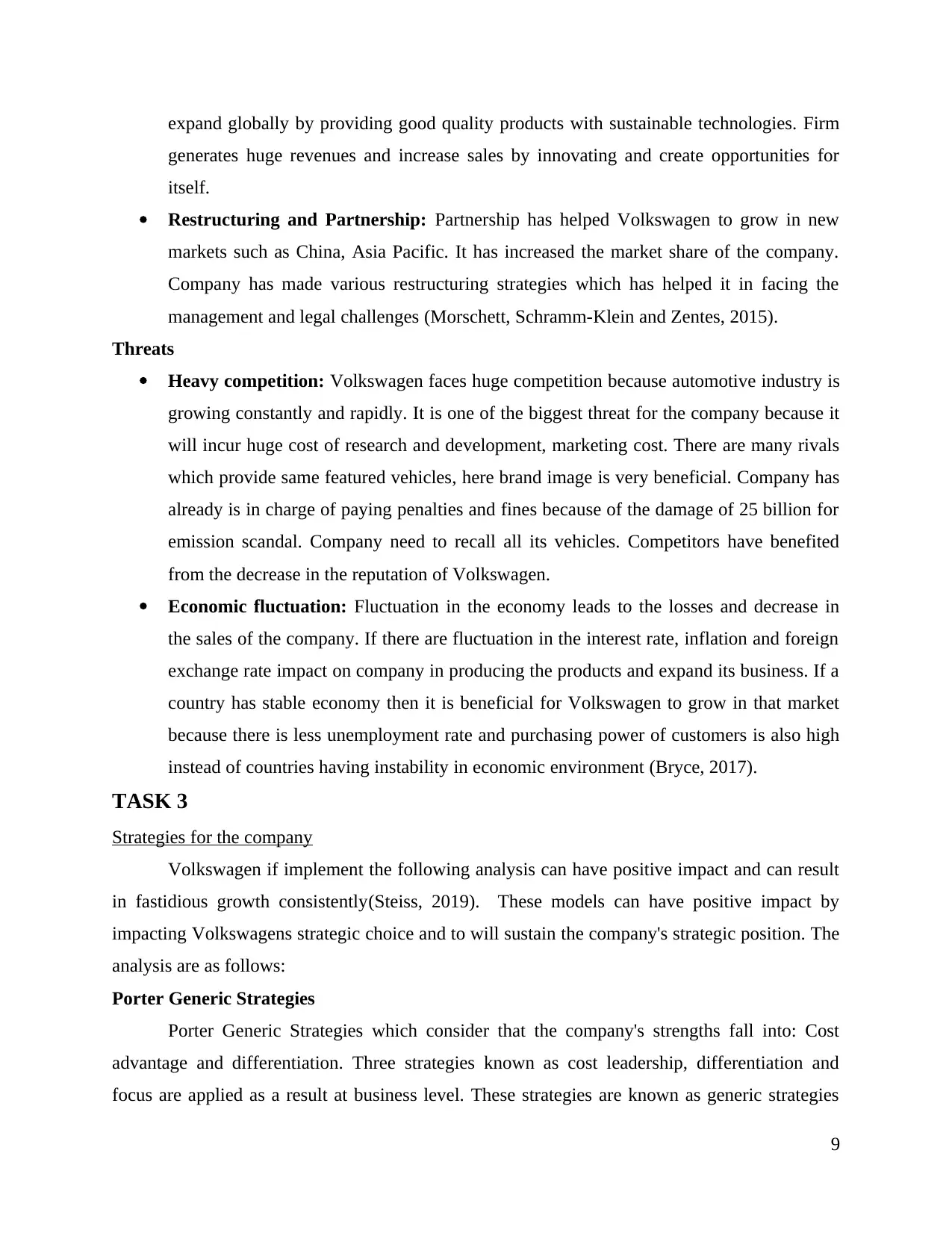
expand globally by providing good quality products with sustainable technologies. Firm
generates huge revenues and increase sales by innovating and create opportunities for
itself.
Restructuring and Partnership: Partnership has helped Volkswagen to grow in new
markets such as China, Asia Pacific. It has increased the market share of the company.
Company has made various restructuring strategies which has helped it in facing the
management and legal challenges (Morschett, Schramm-Klein and Zentes, 2015).
Threats
Heavy competition: Volkswagen faces huge competition because automotive industry is
growing constantly and rapidly. It is one of the biggest threat for the company because it
will incur huge cost of research and development, marketing cost. There are many rivals
which provide same featured vehicles, here brand image is very beneficial. Company has
already is in charge of paying penalties and fines because of the damage of 25 billion for
emission scandal. Company need to recall all its vehicles. Competitors have benefited
from the decrease in the reputation of Volkswagen.
Economic fluctuation: Fluctuation in the economy leads to the losses and decrease in
the sales of the company. If there are fluctuation in the interest rate, inflation and foreign
exchange rate impact on company in producing the products and expand its business. If a
country has stable economy then it is beneficial for Volkswagen to grow in that market
because there is less unemployment rate and purchasing power of customers is also high
instead of countries having instability in economic environment (Bryce, 2017).
TASK 3
Strategies for the company
Volkswagen if implement the following analysis can have positive impact and can result
in fastidious growth consistently(Steiss, 2019). These models can have positive impact by
impacting Volkswagens strategic choice and to will sustain the company's strategic position. The
analysis are as follows:
Porter Generic Strategies
Porter Generic Strategies which consider that the company's strengths fall into: Cost
advantage and differentiation. Three strategies known as cost leadership, differentiation and
focus are applied as a result at business level. These strategies are known as generic strategies
9
generates huge revenues and increase sales by innovating and create opportunities for
itself.
Restructuring and Partnership: Partnership has helped Volkswagen to grow in new
markets such as China, Asia Pacific. It has increased the market share of the company.
Company has made various restructuring strategies which has helped it in facing the
management and legal challenges (Morschett, Schramm-Klein and Zentes, 2015).
Threats
Heavy competition: Volkswagen faces huge competition because automotive industry is
growing constantly and rapidly. It is one of the biggest threat for the company because it
will incur huge cost of research and development, marketing cost. There are many rivals
which provide same featured vehicles, here brand image is very beneficial. Company has
already is in charge of paying penalties and fines because of the damage of 25 billion for
emission scandal. Company need to recall all its vehicles. Competitors have benefited
from the decrease in the reputation of Volkswagen.
Economic fluctuation: Fluctuation in the economy leads to the losses and decrease in
the sales of the company. If there are fluctuation in the interest rate, inflation and foreign
exchange rate impact on company in producing the products and expand its business. If a
country has stable economy then it is beneficial for Volkswagen to grow in that market
because there is less unemployment rate and purchasing power of customers is also high
instead of countries having instability in economic environment (Bryce, 2017).
TASK 3
Strategies for the company
Volkswagen if implement the following analysis can have positive impact and can result
in fastidious growth consistently(Steiss, 2019). These models can have positive impact by
impacting Volkswagens strategic choice and to will sustain the company's strategic position. The
analysis are as follows:
Porter Generic Strategies
Porter Generic Strategies which consider that the company's strengths fall into: Cost
advantage and differentiation. Three strategies known as cost leadership, differentiation and
focus are applied as a result at business level. These strategies are known as generic strategies
9
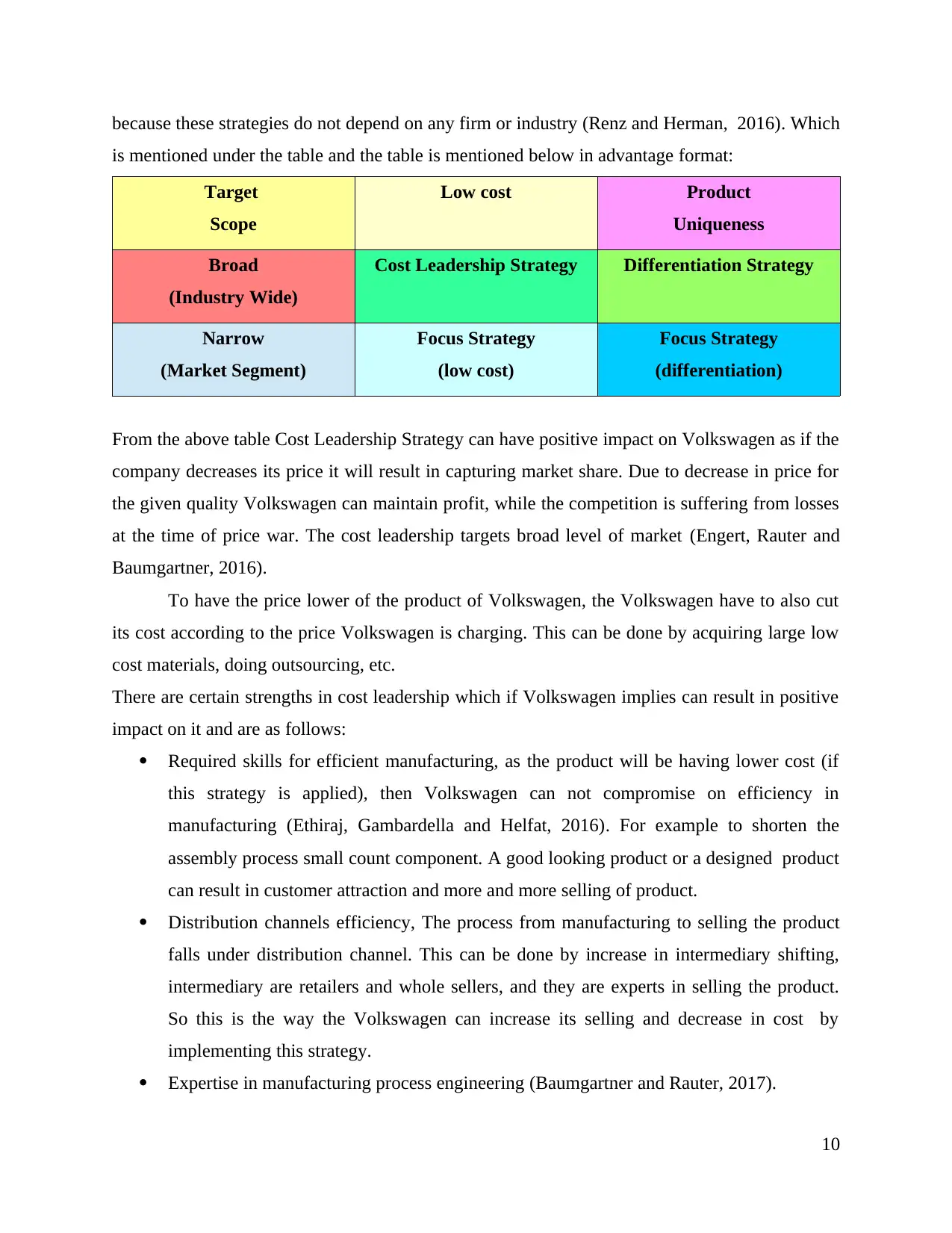
because these strategies do not depend on any firm or industry (Renz and Herman, 2016). Which
is mentioned under the table and the table is mentioned below in advantage format:
Target
Scope
Low cost Product
Uniqueness
Broad
(Industry Wide)
Cost Leadership Strategy Differentiation Strategy
Narrow
(Market Segment)
Focus Strategy
(low cost)
Focus Strategy
(differentiation)
From the above table Cost Leadership Strategy can have positive impact on Volkswagen as if the
company decreases its price it will result in capturing market share. Due to decrease in price for
the given quality Volkswagen can maintain profit, while the competition is suffering from losses
at the time of price war. The cost leadership targets broad level of market (Engert, Rauter and
Baumgartner, 2016).
To have the price lower of the product of Volkswagen, the Volkswagen have to also cut
its cost according to the price Volkswagen is charging. This can be done by acquiring large low
cost materials, doing outsourcing, etc.
There are certain strengths in cost leadership which if Volkswagen implies can result in positive
impact on it and are as follows:
Required skills for efficient manufacturing, as the product will be having lower cost (if
this strategy is applied), then Volkswagen can not compromise on efficiency in
manufacturing (Ethiraj, Gambardella and Helfat, 2016). For example to shorten the
assembly process small count component. A good looking product or a designed product
can result in customer attraction and more and more selling of product.
Distribution channels efficiency, The process from manufacturing to selling the product
falls under distribution channel. This can be done by increase in intermediary shifting,
intermediary are retailers and whole sellers, and they are experts in selling the product.
So this is the way the Volkswagen can increase its selling and decrease in cost by
implementing this strategy.
Expertise in manufacturing process engineering (Baumgartner and Rauter, 2017).
10
is mentioned under the table and the table is mentioned below in advantage format:
Target
Scope
Low cost Product
Uniqueness
Broad
(Industry Wide)
Cost Leadership Strategy Differentiation Strategy
Narrow
(Market Segment)
Focus Strategy
(low cost)
Focus Strategy
(differentiation)
From the above table Cost Leadership Strategy can have positive impact on Volkswagen as if the
company decreases its price it will result in capturing market share. Due to decrease in price for
the given quality Volkswagen can maintain profit, while the competition is suffering from losses
at the time of price war. The cost leadership targets broad level of market (Engert, Rauter and
Baumgartner, 2016).
To have the price lower of the product of Volkswagen, the Volkswagen have to also cut
its cost according to the price Volkswagen is charging. This can be done by acquiring large low
cost materials, doing outsourcing, etc.
There are certain strengths in cost leadership which if Volkswagen implies can result in positive
impact on it and are as follows:
Required skills for efficient manufacturing, as the product will be having lower cost (if
this strategy is applied), then Volkswagen can not compromise on efficiency in
manufacturing (Ethiraj, Gambardella and Helfat, 2016). For example to shorten the
assembly process small count component. A good looking product or a designed product
can result in customer attraction and more and more selling of product.
Distribution channels efficiency, The process from manufacturing to selling the product
falls under distribution channel. This can be done by increase in intermediary shifting,
intermediary are retailers and whole sellers, and they are experts in selling the product.
So this is the way the Volkswagen can increase its selling and decrease in cost by
implementing this strategy.
Expertise in manufacturing process engineering (Baumgartner and Rauter, 2017).
10
⊘ This is a preview!⊘
Do you want full access?
Subscribe today to unlock all pages.

Trusted by 1+ million students worldwide
1 out of 16
Related Documents
Your All-in-One AI-Powered Toolkit for Academic Success.
+13062052269
info@desklib.com
Available 24*7 on WhatsApp / Email
![[object Object]](/_next/static/media/star-bottom.7253800d.svg)
Unlock your academic potential
Copyright © 2020–2025 A2Z Services. All Rights Reserved. Developed and managed by ZUCOL.





